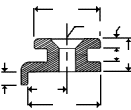 |
Spars, Rigging, and Hardware for SailboatsRig-Rite, Inc. |
Track |
|
|
|
|
 |
Spars, Rigging, and Hardware for SailboatsRig-Rite, Inc. |
Track |
|
|
|
|
| Track | |
|
The idea of using Track for adjustable placement of load bearing fittings, stems
from Nat Herreshoffs' 1887 invention, and subsequent successful implementation, of
Sailtrack. Flat Track with stop holes to position fittings was the next logical development. Flat Track, with a separate Riser, evolved into extruded T-Tracks which incorporate an integral Riser. The concept has since evolved into an astonishing variety of Tracks for cars with wheels or recirculating ball bearings to reduce friction, allowing Track Cars to be adjusted under load. These Tracks, with Cars and Fittings for them are covered under Traveller Systems, and under specific Spar applications, See Spars. See also: Spinnaker Cars, Genoa Cars, Outhaul Cars, Traveller Slides & Stops, Jiffy Reef Slides, and Gooseneck Slides. |
|
|
|
|
|
T-Track, Aluminum T-Track, Bronze T-Track is essentially Flat Track with an integral riser. Commonly used on deck for Jib and Genoa lead Cars and on the Mast for Spinnaker and Gooseneck Slides, it allows for easily adjustable placement of fittings. For Metric T-Track, See: Amiot T-Track and Goiot T-Track.
|
 |
|
Stainless Steel Flat Track
Stainless Steel Flat Track is commonly used on deck for Jib and Genoa lead Cars and on the Mast for Spinnaker and Gooseneck Slides. It allows for easily adjustable placement of fittings and is much more wear resistant than Aluminum T-Track.
|
|
|
Sailtrack, Stainless Steel
Sailtrack, Bronze Sailtrack is primarily used for Storm Trysail Track, as mainsail track on Composite and Wood Spars, and on Aluminum Spars without an integral Luff track. Also used for Jib and Traveller Tracks on smaller boats.
|

|
|
T-Rail T-Rail is the combination of Toerail (used to cover, protect and strengthen the hull to deck joint) and T-Track (to allow for adjustable placement of fittings), combining the benefits of both. |
 |
~ Back to Sailboat Hardware Main Page ~
~ Home ~